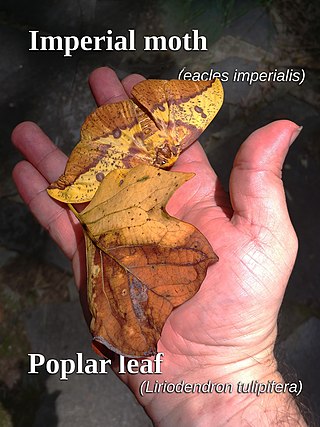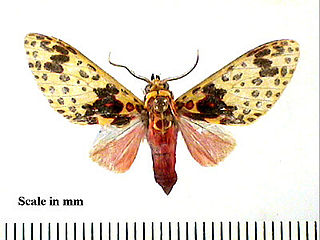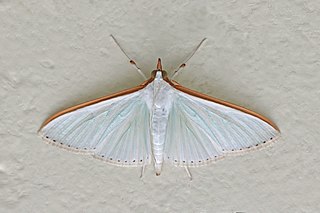
Mimallonidae Burmeister (mimallonids), sometimes known as "sack-bearer" moths for the larval case-building behavior, are a family of Lepidoptera containing over 300 named species in 43 genera. These moths are found only in the New World, with most taxa occurring in the Neotropics. Adult moths are externally similar to those belonging to some of the other Macroheterocera families Bombycoidea and Drepanoidea, and thus have been variously treated as belonging to either one of these or other superfamilies.

Coliadinae, the sulphurs or yellows, are a subfamily of butterflies with about 300 described species.

Eacles is a genus of moths in the family Saturniidae. They are native to the Americas. The genus was erected by Jacob Hübner in 1819.

Amaxia is a genus of moths in the family Erebidae erected by Francis Walker in 1855. The type species of the genus is Amaxia pardalisWalker, 1855.

Leucanopsis is a genus of moths in the family Erebidae. The genus was described by Alfredo Rei do Régo Barros in 1956.

Lophocampa is a genus of moths in the family Erebidae. The genus was erected by Thaddeus William Harris in 1841. It contains around 75 species.

Loxophlebia is a genus of moths in the subfamily Arctiinae. The genus was erected by Arthur Gardiner Butler in 1876.

Trichromia is a genus of moths in the family Erebidae erected by Jacob Hübner in 1819. The members of this genus are largely indigenous to South America.

Diaphania is a genus of moths of the family Crambidae.

Lamprosema is a genus of moths of the family Crambidae described by Jacob Hübner in 1823.

Phostria is a genus of moths of the family Crambidae.

Syllepte is a genus of moths of the family Crambidae.

Cyclophora is a genus of moths in the family Geometridae. Many species are referred to as mochas in reference to their colouration, primarily in Europe.

Papilio aristodemus, the Schaus' swallowtail or island swallowtail, is a species of American butterfly in the family Papilionidae. It is found in southern Florida in the United States and throughout the West Indies. It is named in honor of William Schaus.

William Schaus was an American entomologist who became known for his major contribution to the knowledge and description of new species of the Neotropical Lepidoptera.

Desmia is a genus of moths of the family Crambidae. The genus was erected by John O. Westwood in 1832.
Glaphyria tanamoalis is a moth in the family Crambidae. It was described by William Schaus in 1920. It is found in Cuba.
Neurophyseta durgalis is a moth in the family Crambidae. It was described by William Schaus in 1920. It is found in Guatemala.
Phaedropsis domingalis is a species of moth in the family Crambidae. It was described by William Schaus in 1920. It is found in the Dominican Republic.
Phaedropsis maritzalis is a species of moth in the family Crambidae. It was described by William Schaus in 1920. It has been found in Guatemala, Honduras and Venezuela.













